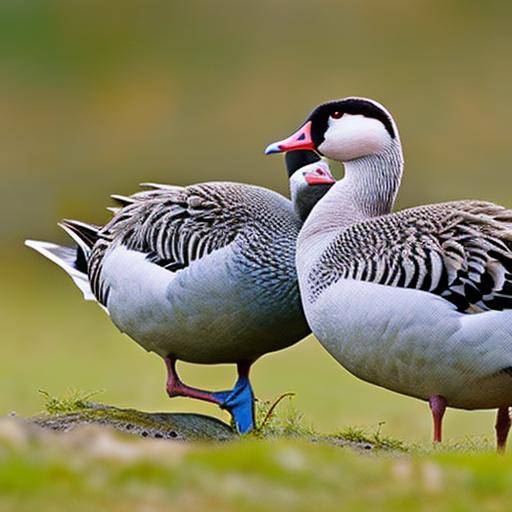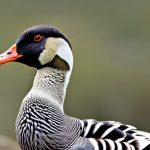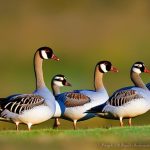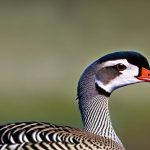Embden geese are a popular breed of domestic geese known for their large size and white plumage. They are commonly raised for meat production and can also be kept as pets or for exhibition purposes. Like other waterfowl, Embden geese have a breeding season during which they mate and lay eggs. Understanding the breeding season is crucial for successful breeding and ensuring the health and productivity of the flock.
Breeding season for Embden geese typically occurs in the spring, although it can vary depending on factors such as climate and geographic location. During this time, male geese, known as ganders, become more aggressive and territorial, while female geese, known as geese, exhibit physical and behavioral changes in preparation for mating and egg laying.
Key Takeaways
- Breeding season for Embden geese brings about physical and behavioral changes.
- Selecting the right mating pair is crucial for successful breeding.
- Nesting habits and egg laying patterns vary among geese.
- Incubation period and hatching of goslings require proper care and attention.
- Preventing predators and ensuring safety is important for optimal breeding results.
Physical and Behavioral Changes During Breeding Season
During the breeding season, both male and female Embden geese undergo physical changes. Male geese develop a larger size and more pronounced neck and head feathers. They also become more aggressive and territorial, often engaging in displays of dominance to attract a mate.
Female geese, on the other hand, experience changes in their reproductive organs. Their oviducts enlarge in preparation for egg production, and they may develop a brood patch on their abdomen to provide warmth for the eggs during incubation. Female geese also exhibit behavioral changes during the breeding season, such as increased vocalization and nesting behavior.
Importance of Selecting the Right Mating Pair
Selecting the right mating pair is crucial for successful breeding in Embden geese. When choosing a mating pair, several factors should be considered. First, it is important to select geese and ganders that are healthy and free from genetic defects or diseases. This will help ensure that the offspring are strong and have a higher chance of survival.
Another factor to consider is compatibility between the mating pair. Geese and ganders should have similar temperaments and be able to get along well. This will reduce stress and aggression during the breeding season, increasing the chances of successful mating and egg production.
Choosing the right mating pair also has benefits for successful breeding. When geese and ganders are well-matched, they are more likely to engage in successful mating behavior and produce fertile eggs. This can lead to a higher hatch rate and healthier goslings.
Nesting Habits and Egg Laying Patterns
Embden geese have specific nesting habits during the breeding season. Female geese will typically choose a secluded spot to build their nests, such as a dense patch of vegetation or a sheltered area. They will use materials such as grass, feathers, and twigs to construct their nests, creating a comfortable and secure environment for their eggs.
The egg laying patterns of Embden geese can vary, but most geese will lay one egg every one to two days until they have laid a clutch of around 8-12 eggs. Once the clutch is complete, the female goose will begin incubating the eggs to keep them warm and facilitate embryonic development.
Incubation Period and Hatching of Goslings
The incubation period for Embden geese is approximately 28-34 days. During this time, the female goose will remain on the nest, rarely leaving except to eat, drink, and bathe. She will rotate the eggs regularly to ensure even heat distribution and proper development.
As the incubation period nears its end, signs of hatching become apparent. The eggs may start to make cracking sounds as the goslings inside begin to break through the shell. The female goose may also become more restless and vocal as she senses that hatching is imminent.
Caring for Goslings: Feeding and Protection

Once the goslings have hatched, it is important to provide them with proper care and nutrition. Goslings should be fed a diet that is high in protein to support their rapid growth and development. This can be achieved through a combination of commercial waterfowl feed and fresh greens.
In addition to feeding, goslings also require protection from predators. Embden geese are vulnerable to a variety of predators, including foxes, raccoons, and birds of prey. Providing a secure enclosure or pen for the goslings can help keep them safe from harm.
Common Health Issues During Breeding Season
Breeding season can also bring about certain health issues in Embden geese. One common issue is egg binding, where a female goose is unable to lay her eggs. This can be caused by factors such as poor nutrition, stress, or genetic predisposition. Egg binding can be a serious condition that requires veterinary intervention.
Another health issue that can arise during breeding season is respiratory infections. Geese are susceptible to respiratory diseases such as avian influenza and duck viral enteritis. Proper biosecurity measures, such as regular cleaning and disinfection of the flock’s living area, can help prevent the spread of these diseases.
Preventing Predators and Ensuring Safety
Embden geese are vulnerable to a variety of predators, both on land and in the air. Common predators include foxes, raccoons, coyotes, dogs, and birds of prey such as hawks and owls. To prevent predation, it is important to provide a secure enclosure or pen for the geese, with fencing that is tall enough to deter predators.
Other measures that can help ensure the safety of Embden geese include installing motion-activated lights or alarms near their living area to scare away potential predators. It is also important to regularly inspect the enclosure for any signs of damage or weakness that could allow predators to gain access.
Breeding Season Management for Optimal Results
Managing the breeding season for Embden geese is crucial for optimal results. This includes providing a suitable environment for mating and egg laying, as well as ensuring proper nutrition and healthcare for the geese.
To create a suitable environment for breeding, it is important to provide nesting boxes or areas where the geese can build their nests. These should be filled with suitable nesting materials such as straw or hay. It is also important to provide a calm and stress-free environment for the geese, as stress can interfere with mating and egg production.
Proper nutrition is also essential during the breeding season. Geese should be fed a balanced diet that is high in protein and essential nutrients. This can be achieved through a combination of commercial waterfowl feed and fresh greens.
The Rewards of Successful Breeding Season for Embden Geese
A successful breeding season for Embden geese can bring about many rewards. It can result in a healthy and productive flock, with a higher hatch rate and stronger goslings. Breeding Embden geese can also be a rewarding experience for the breeder, as it allows them to witness the miracle of life and contribute to the preservation of this beautiful breed.
If you are considering breeding Embden geese, it is important to educate yourself about their breeding season and the care they require. By understanding their physical and behavioral changes, selecting the right mating pair, providing proper nesting and incubation conditions, and ensuring the safety and health of the geese, you can increase your chances of a successful breeding season. So why not give it a try? Breeding Embden geese can be a fulfilling and rewarding endeavor for any waterfowl enthusiast.
If you’re interested in learning more about breeding season for geese, you might also find this article on “How Many Eggs Do Geese Lay?” helpful. It provides valuable insights into the egg-laying habits of geese and offers tips on how to maximize their productivity. To read the article, click here.
FAQs
What is a breeding season for embed geese?
Breeding season for embed geese is the time of year when these birds mate and lay eggs in order to reproduce.
When does the breeding season for embed geese occur?
The breeding season for embed geese typically occurs in the spring and summer months, usually between March and August.
How long does the breeding season for embed geese last?
The breeding season for embed geese can last anywhere from a few weeks to several months, depending on the specific species and environmental conditions.
What are some behaviors exhibited by embed geese during breeding season?
During breeding season, embed geese may become more territorial and aggressive, particularly towards other geese of the same sex. They may also engage in courtship displays and vocalizations to attract mates.
How many eggs do embed geese typically lay during breeding season?
Embed geese typically lay between 4 and 8 eggs per clutch during breeding season.
How long does it take for embed geese eggs to hatch?
Embed geese eggs typically take around 25-30 days to hatch, depending on the specific species and environmental conditions.
What is the role of the male embed goose during breeding season?
Male embed geese play an important role in protecting the nest and eggs during breeding season, as well as helping to incubate the eggs and care for the young once they hatch.
Meet Walter, the feathered-friend fanatic of Florida! Nestled in the sunshine state, Walter struts through life with his feathered companions, clucking his way to happiness. With a coop that’s fancier than a five-star hotel, he’s the Don Juan of the chicken world. When he’s not teaching his hens to do the cha-cha, you’ll find him in a heated debate with his prized rooster, Sir Clucks-a-Lot. Walter’s poultry passion is no yolk; he’s the sunny-side-up guy you never knew you needed in your flock of friends!







